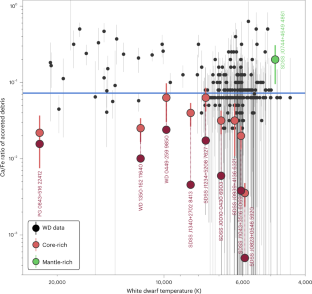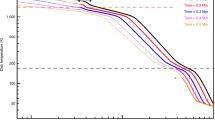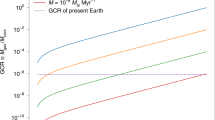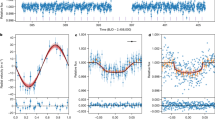Abstract
The timing of formation of the first planetesimals determines the mode of planetary accretion and their geophysical and compositional evolution. Astronomical observations of circumstellar disks and Solar System geochronology provide evidence for planetesimal formation during molecular cloud collapse, much earlier than previously estimated. Here we present distinct observational evidence from white dwarf planetary systems for planetesimal formation occurring during the first few hundred thousand years after cloud collapse in exoplanetary systems. A substantial fraction of white dwarfs have accreted planetary material rich in iron core or mantle material. For the exo-asteroids accreted by white dwarfs to form iron cores, substantial heating is required. By simulating planetesimal evolution and collisional evolution, we show that the most likely heat source is short-lived radioactive nuclides such as 26Al (which has a half-life of ~0.7 Myr). Core-rich materials in the atmospheres of white dwarfs, therefore, provide independent evidence for rapid planetesimal formation, concurrent with star formation.
This is a preview of subscription content, access via your institution
Access options
Access Nature and 54 other Nature Portfolio journals
Get Nature+, our best-value online-access subscription
$29.99 / 30 days
cancel any time
Subscribe to this journal
Receive 12 digital issues and online access to articles
$119.00 per year
only $9.92 per issue
Buy this article
- Purchase on Springer Link
- Instant access to full article PDF
Prices may be subject to local taxes which are calculated during checkout




Similar content being viewed by others
Data availability
The data used to create Figs. 1–4 are available in the Supplementary Information; the white dwarf data (Sample Two) are provided in Supplementary Tables 1–3, while data for Sample One can be found in ref. 26. Source data are provided with this paper.
Code availability
The code used to create Figs. 1–4 and the collisional evolution code is available at https://github.com/abonsor/collcascade and models for Fig. 2 are available at https://github.com/timlichtenberg/2stage_scripts_data.
References
Scherstén, A., Elliott, T., Hawkesworth, C., Russell, S. & Masarik, J. Hf–W evidence for rapid differentiation of iron meteorite parent bodies. Earth Planet. Sci. Lett. 241, 530–542 (2006).
Kruijer, T. S. et al. Protracted core formation and rapid accretion of protoplanets. Science 344, 1150–1154 (2014).
Kleine, T. et al. The non-carbonaceous-carbonaceous meteorite dichotomy. Space Sci. Rev. 216, 55 (2020).
Fedele, D., van den Ancker, M. E., Henning, T., Jayawardhana, R. & Oliveira, J. M. Timescale of mass accretion in pre-main-sequence stars. Astron. Astrophys. 510, A72 (2010).
Najita, J. R. & Kenyon, S. J. The mass budget of planet-forming discs: isolating the epoch of planetesimal formation. Mon. Not. R. Astron. Soc. 445, 3315–3329 (2014).
Tychoniec, Ł. et al. Dust masses of young disks: constraining the initial solid reservoir for planet formation. Astron. Astrophys. 640, A19 (2020).
Sheehan, P. D. & Eisner, J. A. Multiple gaps in the disk of the class I protostar GY 91. Astrophys. J. 857, 18 (2018).
Segura-Cox, D. M. et al. Four annular structures in a protostellar disk less than 500,000 years old. Nature 586, 228–231 (2020).
Stammler, S. M. et al. The DSHARP rings: evidence of ongoing planetesimal formation? Astrophys. J. Lett. 884, L5 (2019).
Carrera, D., Simon, J. B., Li, R., Kretke, K. A. & Klahr, H. Protoplanetary disk rings as sites for planetesimal formation. Astron. J. 161, 96 (2021).
Flock, M. et al. Gaps, rings, and non-axisymmetric structures in protoplanetary disks. From simulations to ALMA observations. Astron. Astrophys. 574, A68 (2015).
Zhang, K., Blake, G. A. & Bergin, E. A. Evidence of fast pebble growth near condensation fronts in the HL Tau protoplanetary disk. Astrophys. J. Lett. 806, L7 (2015).
van der Marel, N. & Mulders, G. D. A stellar mass dependence of structured disks: a possible link with exoplanet demographics. Astron. J. 162, 28 (2021).
Mulders, G. D., Pascucci, I., Ciesla, F. J. & Fernandes, R. B. The mass budgets and spatial scales of exoplanet systems and protoplanetary disks. Astrophys. J. 920, 66 (2021).
Jura, M. & Young, E. D. Extrasolar cosmochemistry. Annu. Rev. Earth. Planet. Sci. 42, 45–67 (2014).
Farihi, J. Circumstellar debris and pollution at white dwarf stars. N. Astron. Rev. 71, 9–34 (2016).
Fontaine, G. & Michaud, G. Diffusion time scales in white dwarfs. Astrophys. J. 231, 826–840 (1979).
Koester, D. Accretion and diffusion in white dwarfs. New diffusion timescales and applications to GD 362 and G 29-38. Astron. Astrophys. 498, 517–525 (2009).
Zuckerman, B., Melis, C., Klein, B., Koester, D. & Jura, M. Ancient planetary systems are orbiting a large fraction of white dwarf stars. Astrophys. J. 722, 725–736 (2010).
Koester, D., Gänsicke, B. T. & Farihi, J. The frequency of planetary debris around young white dwarfs. Astron. Astrophys. 566, A34 (2014).
Melis, C. et al. Accretion of a terrestrial-like minor planet by a white dwarf. Astrophys. J. 732, 90 (2011).
Gänsicke, B. T. et al. The chemical diversity of exo-terrestrial planetary debris around white dwarfs. Mon. Not. R. Astron. Soc. 424, 333–347 (2012).
Wilson, D. J. et al. The composition of a disrupted extrasolar planetesimal at SDSS J0845+2257 (Ton 345). Mon. Not. R. Astron. Soc. 451, 3237–3248 (2015).
Buchan, A. M. et al. Planets or asteroids? A geochemical method to constrain the masses of white dwarf pollutants. Mon. Not. R. Astron. Soc. 510, 3512–3530 (2022).
Harrison, J. H. D., Bonsor, A. & Madhusudhan, N. Polluted white dwarfs: constraints on the origin and geology of exoplanetary material. Mon. Not. R. Astron. Soc. 479, 3814–3841 (2018).
Harrison, J. H. D. et al. Bayesian constraints on the origin and geology of exoplanetary material using a population of externally polluted white dwarfs. Mon. Not. R. Astron. Soc. 504, 2853–2867 (2021).
Krot, A. N., Amelin, Y., Cassen, P. & Meibom, A. Young chondrules in CB chondrites from a giant impact in the early Solar System. Nature 436, 989–992 (2005).
Jura, M., Xu, S. & Young, E. D. 26Al in the early Solar System: not so unusual after all. Astrophys. J. Lett. 775, L41 (2013).
Wasserburg, G. J., Lee, T. & Papanastassiou, D. A. correlated O And Mg isotopic anomalies in Allende inclusions: II. Magnesium. Geophys. Res. Lett. 4, 299–302 (1977).
Tang, H. & Dauphas, N. Abundance, distribution, and origin of 60Fe in the solar protoplanetary disk. Earth Planet. Sci. Lett. 359, 248–263 (2012).
Lugaro, M., Ott, U. & Kereszturi, Á. Radioactive nuclei from cosmochronology to habitability. Prog. Part. Nucl. Phys. 102, 1–47 (2018).
Gounelle, M. The abundance of 26Al-rich planetary systems in the galaxy. Astron. Astrophys. 582, A26 (2015).
Young, E. D. Inheritance of solar short- and long-lived radionuclides from molecular clouds and the unexceptional nature of the solar system. Earth Planet. Sci. Lett. 392, 16–27 (2014).
Lichtenberg, T., Parker, R. J. & Meyer, M. R. Isotopic enrichment of forming planetary systems from supernova pollution. Mon. Not. R. Astron. Soc. 462, 3979–3992 (2016).
Kuffmeier, M., Frostholm Mogensen, T., Haugbølle, T., Bizzarro, M. & Nordlund, Å. Tracking the distribution of 26Al and 60Fe during the early phases of star and disk evolution. Astrophys. J. 826, 22 (2016).
Côté, B. et al. Galactic chemical evolution of radioactive isotopes. Astrophys. J. 878, 156 (2019).
Fatuzzo, M. & Adams, F. C. Theoretical distributions of short-lived radionuclides for star formation in molecular clouds. Astrophys. J. 925, 56 (2022).
Forbes, J. C., Alves, J. & Lin, D. N. C. A Solar System formation analogue in the Ophiuchus star-forming complex. Nat. Astron. 5, 1009–1016 (2021).
Reiter, M. Observational constraints on the likelihood of 26Al in planet-forming environments. Astron. Astrophys. 644, L1 (2020).
Lichtenberg, T., Dra̧żkowska, J., Schönbächler, M., Golabek, G. J. & Hands, T. O. Bifurcation of planetary building blocks during Solar System formation. Science 371, 365–370 (2021).
Hughes, A. M., Duchêne, G. & Matthews, B. C. Debris disks: structure, composition, and variability. Annu. Rev. Astron. Astrophys. 56, 541–591 (2018).
Marcus, R. A., Sasselov, D., Hernquist, L. & Stewart, S. T. Minimum radii of super-earths: constraints from giant impacts. Astrophys. J. Lett. 712, L73–L76 (2010).
Carter, P. J., Leinhardt, Z. M., Elliott, T., Walter, M. J. & Stewart, S. T. Compositional evolution during rocky protoplanet accretion. Astrophys. J. 813, 72 (2015).
Debes, J. H. & Sigurdsson, S. Are there unstable planetary systems around white dwarfs? Astrophys. J. 572, 556–565 (2002).
Elkins-Tanton, L. T., Weiss, B. P. & Zuber, M. T. Chondrites as samples of differentiated planetesimals. Earth Planet. Sci. Lett. 305, 1–10 (2011).
Payne, M. J., Veras, D., Holman, M. J. & Gänsicke, B. T. Liberating exomoons in white dwarf planetary systems. Mon. Not. R. Astron. Soc. 457, 217–231 (2016).
Veras, D., Mustill, A. J., Bonsor, A. & Wyatt, M. C. Simulations of two-planet systems through all phases of stellar evolution: implications for the instability boundary and white dwarf pollution. Mon. Not. R. Astron. Soc. 431, 1686–1708 (2013).
Veras, D. Post-main-sequence planetary system evolution. R. Soc. Open Sci. 3, 150571 (2016).
Farihi, J. et al. Scars of intense accretion episodes at metal-rich white dwarfs. Mon. Not. R. Astron. Soc. 424, 464–471 (2012).
Krivov, A. V. & Wyatt, M. C. Solution to the debris disc mass problem: planetesimals are born small? Mon. Not. R. Astron. Soc. 500, 718–735 (2021).
Wyatt, M. C. Evolution of debris disks. Annu. Rev. Astron. Astrophys. 46, 339–383 (2008).
Wyatt, M. C. et al. Steady state evolution of debris disks around a stars. Astrophys. J. 663, 365–382 (2007).
Lichtenberg, T. & Krijt, S. System-level fractionation of carbon from disk and planetesimal processing. Astrophys. J. Lett. 913, L20 (2021).
Wordsworth, R. & Kreidberg, L. Atmospheres of rocky exoplanets. Preprint at https://arxiv.org/abs/2112.04663 (2021).
Dra̧żkowska, J., Stammler, S. M. & Birnstiel, T. How dust fragmentation may be beneficial to planetary growth by pebble accretion. Astron. Astrophys. 647, A15 (2021).
Brewer, J. M., Fischer, D. A., Valenti, J. A. & Piskunov, N. Spectral properties of cool stars: extended abundance analysis of 1,617 planet-search stars. Astrophys. J. Suppl. Ser. 225, 32 (2016).
Fischer, R. A. et al. High pressure metal-silicate partitioning of Ni, Co, V, Cr, Si, and O. Geochim. Cosmochim. Acta 167, 177–194 (2015).
Corgne, A. & Wood, B. J. Element partitioning during core formation. Geochim. Cosmochim. Acta 72(Suppl), A178 (2008).
Wade, J. & Wood, B. J. Core formation and the oxidation state of the Earth. Earth Planet. Sci. Lett. 236, 78–95 (2005).
Wood, B. J., Wade, J. & Kilburn, M. R. Core formation and the oxidation state of the Earth: additional constraints from Nb, V and Cr partitioning. Geochim. Cosmochim. Acta 72, 1415–1426 (2008).
Cottrell, E., Walter, M. J. & Walker, D. Metal-silicate partitioning of tungsten at high pressure and temperature: Implications for equilibrium core formation in Earth. Earth Planet. Sci. Lett. 281, 275–287 (2009).
Siebert, J., Badro, J., Antonangeli, D. & Ryerson, F. J. Metal-silicate partitioning of Ni and Co in a deep magma ocean. Earth Planet. Sci. Lett. 321, 189–197 (2012).
Hollands, M. A., Koester, D., Alekseev, V., Herbert, E. L. & Gänsicke, B. T. Cool DZ white dwarfs - I. Identification and spectral analysis. Mon. Not. R. Astron. Soc. 467, 4970–5000 (2017).
Hollands, M. A., Gänsicke, B. T. & Koester, D. Cool DZ white dwarfs II:compositions and evolution of old remnant planetary systems. Mon. Not. R. Astron. Soc. 477, 93 (2018).
Blouin, S. Magnesium abundances in cool metal-polluted white dwarfs. Mon. Not. R. Astron. Soc. 496, 1881–1890 (2020).
Bonsor, A. et al. Are exoplanetesimals differentiated? Mon. Not. R. Astron. Soc. 492, 2683–2697 (2020).
Hollands, M. A., Tremblay, P.-E., Gänsicke, B. T., Koester, D. & Gentile-Fusillo, N. P. Alkali metals in white dwarf atmospheres as tracers of ancient planetary crusts. Nat. Astron. 5, 451–459 (2021).
Zuckerman, B. et al. An aluminum/calcium-rich, iron-poor, white dwarf star: evidence for an extrasolar planetary lithosphere? Astrophys. J. 739, 101 (2011).
Sellke, T., Bayarri, M. J. & Berger, J. O. Calibration of rho values for testing precise null hypotheses. Am. Stat. 55, 62–71 (2001).
Xu, S. et al. Compositions of planetary debris around dusty white dwarfs. Astron. J. 158, 242 (2019).
Wyatt, M. C., Clarke, C. J. & Booth, M. Debris disk size distributions: steady state collisional evolution with Poynting-Robertson drag and other loss processes. Celest. Mech. Dynam. Astron. 111, 1–28 (2011).
Dohnanyi, J. S. Collisional model of asteroids and their debris. J. Geophys. Res. 74, 2531–+ (1969).
Benz, W. & Asphaug, E. Catastrophic disruptions revisited. Icarus 142, 5–20 (1999).
Durda, D. D., Greenberg, R. & Jedicke, R. Collisional models and scaling laws: a new interpretation of the shape of the main-belt asteroid size distribution. Icarus 135, 431–440 (1998).
Löhne, T., Krivov, A. V. & Rodmann, J. Long-term collisional evolution of debris disks. Astrophys. J. 673, 1123–1137 (2008).
Wyatt, M. C. et al. Transience of hot dust around Sun-like stars. Astrophys. J. 658, 569–583 (2007).
Bonsor, A. & Wyatt, M. Post-main-sequence evolution of a star debris discs. Mon. Not. R. Astron. Soc. 409, 1631–1646 (2010).
Acknowledgements
A.B. acknowledges support from a Royal Society Dorothy Hodgkin Research Fellowship (grant number DH150130) and a Royal Society University Research Fellowship (grant number URF\R1\211421). T.L. was supported by a grant from the Simons Foundation (SCOL award number 611576). J.D. acknowledges funding from the European Research Council (ERC) under the European Union’s Horizon 2020 research and innovation programme under grant agreement number 714769. A.M.B. acknowledges support from a Royal Society funded PhD studentship (grant number RGFEA180174). We acknowledge fruitful discussions with M. Brouwers, L. Rogers, E. Lynch, A. Curry, T. Birnstiel, M. Wyatt and R. J. Parker.
Author information
Authors and Affiliations
Contributions
The idea for the study came from discussions between A.B., J.D. and T.L. The analysis of the white dwarf data was performed by A.M.B. and T.L. supplied the thermal evolution models used for Fig. 2. All authors contributed to writing the manuscript.
Corresponding author
Ethics declarations
Competing interests
The authors declare no competing interests.
Peer review
Peer review information
Nature Astronomy thanks the anonymous reviewers for their contribution to the peer review of this work
Additional information
Publisher’s note Springer Nature remains neutral with regard to jurisdictional claims in published maps and institutional affiliations.
Supplementary information
Supplementary Information
Supplementary Fig. 1, Tables 1–3 and references.
Supplementary Data 1
Machine-readable version of Supplementary Table 1.
Supplementary Data 2
Machine-readable version of Supplementary Table 2.
Supplementary Data 3
Machine-readable version of Supplementary Table 3.
Source data
Rights and permissions
Springer Nature or its licensor (e.g. a society or other partner) holds exclusive rights to this article under a publishing agreement with the author(s) or other rightsholder(s); author self-archiving of the accepted manuscript version of this article is solely governed by the terms of such publishing agreement and applicable law.
About this article
Cite this article
Bonsor, A., Lichtenberg, T., Dra̧żkowska, J. et al. Rapid formation of exoplanetesimals revealed by white dwarfs. Nat Astron 7, 39–48 (2023). https://doi.org/10.1038/s41550-022-01815-8
Received:
Accepted:
Published:
Issue Date:
DOI: https://doi.org/10.1038/s41550-022-01815-8



